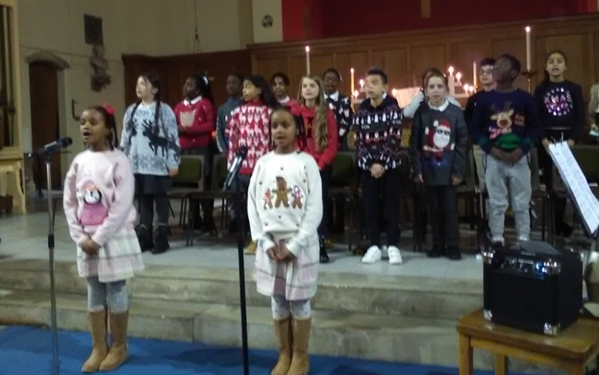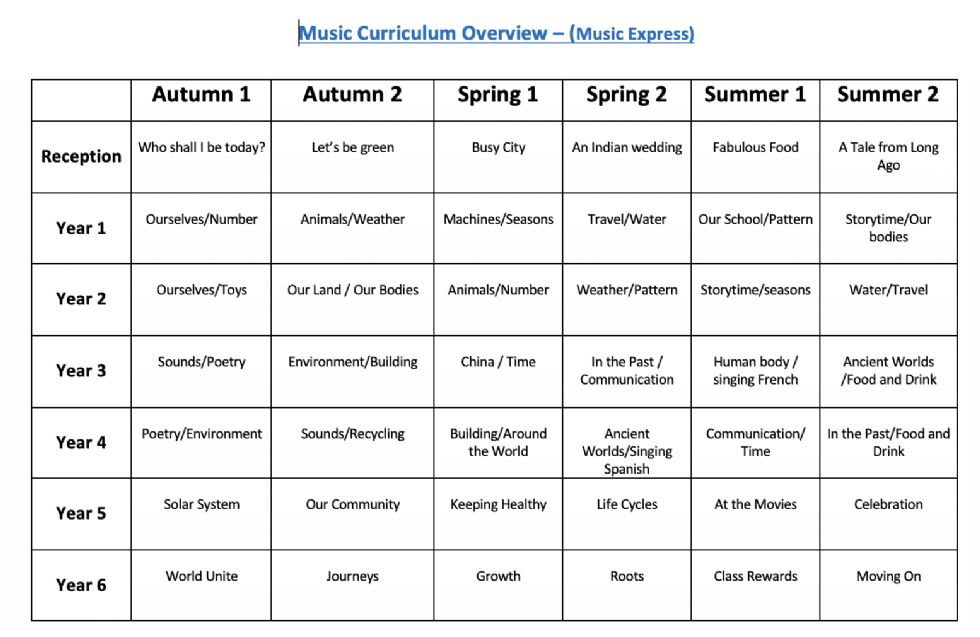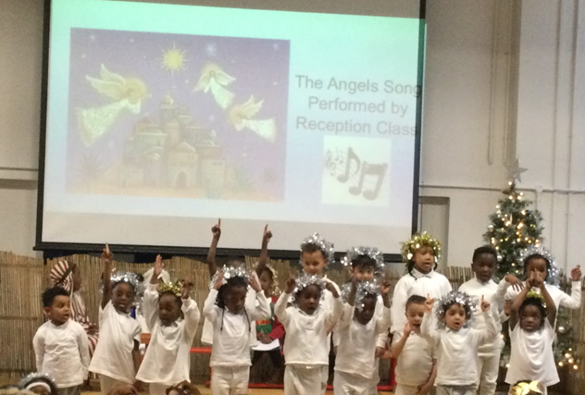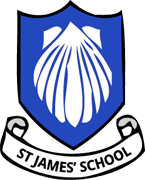Music

Intent – what are we trying to achieve?
Music plays a very important role within our life as a Church school and is woven into daily routines as well as taught as a subject in its own right. We are proud of our pupil’s engagement and enthusiasm in this area and celebrate this by providing numerous opportunities for our children to perform through collective worship, class assemblies, church services, concerts, performances and festivals.
Music is a universal language that embodies one of the highest forms of creativity. At St. James’ we believe that a high-quality music education should engage and inspire pupils to develop a love of music and their talent as musicians, and so increase their self-confidence, creativity and sense of achievement. As pupils progress, they should develop a critical engagement with music, allowing them to compose, listen with discrimination, and so increase their self-confidence, creativity and have a sense of achievement.
The Teaching of Music
Implementation – how do we translate our vision into practice?
Our children are given many opportunities to compose, listen, perform and appraise, as well as to apply their understanding of the dimensions of music as they refine their skills in these.
In the early Years, music is incorporated consistently into daily routines and is used to enhance teaching of the core curriculum, in addition to being taught as a stand-alone subject. All year groups including the early years also participate in weekly music assemblies (collective worship) alongside a separate weekly music lesson for Years 1-6.
We use the programme Music Express to deliver the music curriculum. (Please also refer to the progression and skills documents alongside the overview below) Music Express uses a topic-based, cross-curricular approach to support children's learning in music and across other subjects through music. It is planned to provide steady progression, both within each year and from one year to the next, ensuring consistent musical development. In addition, it also fulfils the aims for musical learning stated in the English National Curriculum as detailed below:

EYFS Framework
Expressive arts and design involves enabling children to explore and play with a wide range of media and materials, as well as providing opportunities and encouragement for sharing their thoughts, ideas and feelings through a variety of activities in art, music, movement, dance, role-play, and design and technology.
Music also supports and develops the three prime areas of the framework:
Communication and language Physical development Personal, social and emotional development
1. Using Voices:
- Change voices for effect to express a mood/feeling
- Use and recognise range of voices - speaking/whispering/speaking/thinking
- Sing using and developing awareness of high and low/loud and quiet sounds
- Call and response/chants
2. Using instruments/sounds sources:
- Explore untuned percussion instruments and how sounds are made
- Explore environmental sounds
- Choose an instrument to make a specific sound
- Start to describe sounds (e.g. loud/quiet, high/low)
- Keep a steady beat using actions whilst singing
3. Listening and responding:
- Start to follow musical instructions,
- Be able to start and stop together in a group
- Recognise sound/silence, loud/quiet, fast/slow sounds in listening
- Listen to and talk about sounds
- Respond to music with movement and actions
- Keep a steady beat in a group whilst singing/listening
National Curriculum – Key Stage 1
Pupils should be taught to:
1. use their voices expressively and creatively by singing songs and speaking chants and rhymes
2. play tuned and untuned instruments musically
3. listen with concentration and understanding to a range of high-quality live and recorded music
4. experiment with, create, select and combine sounds using the inter-related dimensions of music.
YEAR 1
1.
- Use their voices expressively and creatively by singing songs and speaking chants and rhymes
- Be able to convey different moods and emotions
- Show vocal control of variety of voices - whispering/singing/speaking
- Sing with awareness of pulse and rhythm
- Start to follow pitch movements with hands and voices and begin to sing with control of pitch
2.
- Play tuned and untuned percussion instruments musically
- Demonstrate increased control and care of instruments
Be able to copy short rhythm patterns - Call and response - Be able to create, clap and play short rhythmic patterns
- Explore high and low sounds
3.
- Listen with concentration and understanding to a range of high-quality live and recorded music
- Be able to identify a steady beat in music
- Listen to range of songs and recall phrases
- Listen to and start to identify percussion instruments and other sound sources
- Be able to identify musical elements (e.g. loud/quiet, fast/slow, long/short)
- Be able to recognise, respond to and talk about changes in musical elements (e.g. loud/quiet, fast/slow, high/low)
- Be able to talk about how music makes them feel
4.
- Experiment with, create and select and combine sounds using the inter-related dimensions of music
Investigate and explore sounds in order to choose sounds they wish to use - Start to use shapes and marks to represent high/low and long/short sounds
- Be able create ‘pulse’ actions to go with a song (e.g. clapping or playing an instrument)
- Be able to ‘group’ percussion instruments
- To begin to understand how musical features can be used to create different moods and effects (e.g. loud and fast sounds/slow and long sounds)
YEAR 2
1.
- Use their voices expressively and creatively by singing songs and speaking chants and rhymes:
Sing a wider variety of songs, (e.g. rounds/partner songs, longer songs and songs with more words - Sing with an awareness of musical shape
- Be able to identify and show the shape of a melody with hand movements
- Sing with awareness of and control of dynamics, pitch, and long and short sounds
2.
- Play tuned and un-tuned percussion instruments musically
Demonstrate control and care of instruments - Be able to copy back rhythm patterns
- Be able to copy back short pitched patterns
- Be able to play repeated patterns
- Be able to make up short 3 note tunes
3.
- Listen with concentration and understanding to a range of high-quality live and recorded music
- Listen with increased awareness for particular musical elements/features
- Be able to compare the tempo and dynamics in two contrasting pieces of music
- Reflect on and appraise their own and others’ musical performances and identify a target for improvement
4.
- Experiment with, create and select and combine sounds using the inter-related dimensions of music
Explore, choose and select sounds for particular effect/purpose - Start to combine different sounds to produce short pieces from a given starting point
- Show awareness of structure through organising/ordering sounds (e.g. creating a beginning and end/use of repetition
- Be able to create soundscapes from a given stimulus
- Be able to interpret a range of visual symbols to represent changes in sound
- Be able to devise graphic shapes, using symbols to represent sounds, to notate ideas
- To understand how musical features can be combined to create different moods and effects
National Curriculum – Key Stage 2
Pupils should be taught to sing and play musically with increasing confidence and control. They should develop an understanding of musical composition, organising and manipulating ideas within musical structures and reproducing sounds from aural memory. Pupils should be taught to:
1. play and perform in solo and ensemble contexts, using their voices and playing musical instruments with increasing accuracy, fluency, control and expression
2. improvise and compose music for a range of purposes using the inter-related dimensions of music
3. listen with attention to detail and recall sounds with increasing aural memory
4. use and understand staff and other musical notations
5. appreciate and understand a wide range of high-quality live and recorded music drawn from different traditions and from great composers and musicians
6. develop an understanding of the history of music
YEAR 3
1. Play and perform in solo and ensemble contexts, using their voices and playing musical instruments with increasing accuracy, fluency, control and expression:
- Understand good posture and technique for singing and playing an instrument.
- Sing a greater range of songs (e.g. longer structure/2 part rounds/songs with more words)
- To start to sing with expression and control
- Be able to perform simple melodies on an instrument
- Be able to perform within a class ensemble to an accompaniment
- Be able to perform simple rhythmic/melodic patterns on an instrument to accompany a song
2. Improvise and compose music for a range of purposes using the inter-related dimensions of music:
- Be able to improvise repeated patterns
- Be able to improvise/compose short tunes using three notes
- Be able to compose in pairs/threes using a variety of starting points
- Start to combine sounds to create desired effect
- Be able to choose and order sounds within a simple framework/structure
3. Listen with attention to detail and recall sounds with increasing aural memory:
- Listen to music from a wider variety of traditions and styles
- Begin to place music on a time line
- Begin to express opinions about music using musical terminology
- Reflecting on and improving work against a given criteria
- Begin to use terms duration/timbre/tempo/pitch/texture when describing music
- Evaluate the work of others considering these features
4. Use and understand staff and other musical notations:
- Using graphic symbols to represent different sounds and instruments in listening and composing tasks
- Begin to understand rhythmic notation and simplified ‘traditional’ notation through instrumental work
5. Appreciate and understand a wide range of high quality live and recorded music drawn from different traditions and from great composers and musicians
6. Develop an understanding of the history of music
- Be able to identify a greater variety of musical features within one piece
- To have an awareness of a greater number of musical styles and performers
- Be aware that music changes depending on the time and place of composition
YEAR 4
1. Play and perform in solo and ensemble contexts, using their voices and playing musical instruments with increasing accuracy, fluency, control and expression:
- Be able to sing 3 and 4 part rounds
- Start to add harmony parts within a group
- Show awareness of how to communicate to an audience
- Show increased control of posture, breathing and diction
- Develop instrumental technique and skills and be able to maintain simple accompaniments with an awareness of the ensemble
2 Improvise and compose music for a range of purposes using the inter-related dimensions of music:
- Show increased awareness of selecting/ordering sounds for a particular effect
- Be able to use wider ‘note sets’ with competence
- Improvise melodies on a 5 note scale
- Compose in a group setting using a variety of starting points
- Start to organize sounds into a range of compositional structures (e.g. call and response/ABA)
- Start to combine and layer sounds within short compositions to create different textures
3. Listen with attention to detail and recall sounds with increasing aural memory:
- Understand and comment on what makes a good composition or performance
- Reflect on and evaluate their own work and that of others and share ways of improving
- Discuss the overall effect and impact of a piece
- Identify some structural and expressive features of a piece
4. Use and understand staff and other musical notations:
- Be able to compose and notate a 2 bar rhythm
- Show increasing confidence and ability to interpret rhythmic and melodic notation
5. Appreciate and understand a wide range of high quality live and recorded music drawn from different traditions and from great composers and musicians
6. Develop an understanding of the history of music
- Be able to identify and discuss musical features within pieces from different traditions
- Be able to identify and discuss musical features within pieces from different points in history
- Begin to place music on a time line
YEAR 5
1. Play and perform in solo and ensemble contexts, using their voices and playing musical instruments with increasing accuracy, fluency, control and expression:
- Sing a more demanding and varied repertoire in a range of styles
- Sing with increased clarity and diction
- Sing with awareness of ensemble blend
- Sing/play with awareness of and sense of phrasing and shape
- Start to maintain own part in a round or harmony (played or sung)
2. Improvise and compose music for a range of purposes using the inter-related dimensions of music:
- Be able to create and combine melodic lines
- Be able to improvise melodically within a larger ‘note set’
- Choose, create and layer sounds with control
- Be able to order/structure ideas more clearly to create longer pieces
- Compose to a specific ‘brief’ to portray an idea, theme or mood
- Be able to use simple digital technology as a composition/notation tool
3. Listen with attention to detail and recall sounds with increasing aural memory:
- Compare pieces thinking about structure, texture, dynamics and tempo
- Evaluate the work of others thinking about structure, texture…and understand what makes a successful composition
- Be able to identify musical elements within a piece and be able to discuss them
4. Use and understand staff and other musical notations:
- Start to find own ways to write down pieces · Be able to devise/use own graphic notation
- Develop understanding of traditional rhythmic notation
- Begin to recognise pitched staff notation through songs and instrumental work
5. Appreciate and understand a wide range of high quality live and recorded music drawn from different traditions and from great composers and musicians
6 Develop an understanding of the history of music
- Recognise and talk about specific styles of music
- Be able to recognise and compare musical features from pieces within different traditions
- Be able to recognise and compare musical features within pieces from different points in history
- Develop a greater understanding of how music has developed over time
YEAR 6
1. Play and perform in solo and ensemble contexts, using their voices and playing musical instruments with increasing accuracy, fluency, control and expression
- Sing with good control of posture breathing, vocal control and technique, diction, phrasing and projection
- Sing or play with increased sense of character and style and ability to communicate to an audience
- Perform with awareness of context/environment
- Perform with awareness of others
- Be able to maintain a part in a three part round or a harmony part
2. Improvise and compose music for a range of purposes using the inter-related dimensions of music:
- Select sounds to convey an idea or effect
- Develop, improve and refine compositions
- Be able to compose in a variety of styles and forms using more complex, extended structures (e.g. Blues / Rondo / Verse and Chorus / Theme and Variations
- Be able to improvise melodic and rhythmic phrases within a framework over a backing
- Combine an extended range of sounds to create music
- Explore, use and combine a wide range of sounds and musical devices (e.g. clusters / chords / scales / lyrics / harmony · Show increased confidence in making composition choices
- Use digital music technology as a composition/notation aid with greater confidence
- Create music reflecting given intentions/themes
3. Listen with attention to detail and recall sounds with increasing aural memory:
- Listen to and identify what makes a good performance or composition
- Be able to pick out musical details from a piece of music.
- Be able to identify and discuss a wide range of musical elements
- Be able to compare and evaluate pieces using a range of musical vocabulary
4. Use and understand staff and other musical notations:
- Use appropriate musical signs and symbols to notate work
- Be able to perform short pieces from a notated score
- Recognising pitched staff notation for simple rhythm/melody
- Be able to understanding different time signatures
5. Appreciate and understand a wide range of high quality live and recorded music drawn from different traditions and from great composers and musicians
6. Develop an understanding of the history of music:
- Be able to identify how occasion, purpose and venue affect the way music is created
- Be able to compare and contrast musical features within two pieces using an extended range of musical terminology
- Be able to distinguish and describe differences in texture (layers) and timbre (quality of sound)
- Understand what makes a makes a successful performance
- Show the ability to give opinions with confident use of musical terminology
- Be able to identify and appraise musical features within pieces and how they contribute to the style and mood of the music
- Be able to identifying similarities and differences between composers/styles/traditions
- Be able to describe how music has evolved over time

Enrichment Opportunities
Productions - We have a number of productions that take place yearly with every child given the opportunity to sing and perform to an audience. This is in addition to their class assemblies. At Christmas Reception, Year 1 and 2 rehearse and perform a Christmas Nativity, while Years 3, 4 and 5 lead and present a version of 12 Lessons and Carols in church while Year 6 lead the Christingle Service. At the end of the school year, Year 6 pupils also perform in an end of year production, which allows them to combine their talents in drama, dance, music, art and theatre production to the delight of their audience.
Instrumental Lessons - These are available through the Enfield Music Service (for further information on individual instrumental lessons delivered by peripatetic teachers) please contact the office or Enfield Music Service directly.
EMS website address is: http://www.enfield.gov.uk
(search 'Enfield Music Service' to find the EMS pages)
Email contact: info@enfieldmusicservice.org
Choir – Coming soon!
Outcomes
Impact – what is the impact of our music curriculum on our students?
Our music curriculum and the music culture within our school allows pupils to build on their skills and taught knowledge as they move through the school. This ensures that they not only develop as musicians and performers year-on-year but also through their understanding and appreciation of music develop as listeners and appraisers, with the musical vocabulary to support this. Our expectation at St. James’ is that our curriculum should foster a passion for music, both engaging and inspiring our pupils while increasing their self-confidence and creativity.
